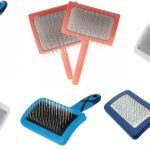Are you tired of your dog constantly pulling and tugging during walks, making the experience more stressful than enjoyable? Do you wish there was a solution to make your walks together more peaceful and hassle-free? Say goodbye to those tangled leashes and strained arms because we have the answer!
Introducing the revolutionary anti-pull dog leash, a game-changer for dog owners everywhere. This specially designed leash is the key to transforming your walks into pleasant and tangle-free adventures.

The current best selling "Anti Pull Dog Lead" on Amazon is the "HALTI Headcollar", it's a great harness to stop your dog pulling on the lead.
It's very simple to use and has a nice padded nose band for your dogs comfort.
They come in 5 different sizes and a variety of colours.
With its innovative design and unique features, the anti-pull dog leash provides you with the control and ease you've been longing for during your walks. Bid farewell to the frustrations of your dog pulling and dragging you along!
In this article, we will explore the importance of leash training for dogs and dive into the benefits and functionality of the no-pull dog leash. Get ready to discover the secrets to stress-free walks that will strengthen your bond with your furry friend.
Key Takeaways:
- Discover the game-changing benefits of the anti-pull dog leash.
- Understand the importance of leash training for dogs.
- Explore the unique features and functionality of the no-pull dog leash.
- Learn how an anti-pull dog leash works to prevent pulling behavior.
- Gain insights into choosing the right leash for your specific needs.
Understanding the Importance of Leash Training
Leash training is a vital aspect of responsible dog ownership. It not only ensures the safety of both the dog and the owner but also fosters a positive walking experience. In this section, we will explore the significance of leash training and why it is necessary to address pulling behavior in dogs.
When a dog pulls on the leash during walks, it can lead to various problems. It can cause physical strain on both the dog and the owner, putting them at risk of injuries. Additionally, pulling behavior can be dangerous, as it increases the chances of the dog breaking free and running into traffic or engaging in aggressive encounters with other dogs or pedestrians.
Leash training provides several benefits. Firstly, it establishes boundaries and teaches dogs to walk calmly by their owner's side. This not only enhances their obedience but also improves their overall behavior and mindset. Furthermore, leash training allows owners to maintain control in any situation, whether walking on a crowded street, encountering distractions, or navigating unfamiliar environments.
To effectively address pulling behavior, it is essential to understand its underlying causes. Dogs may pull on the leash due to excitement, the desire to explore or chase something, or a lack of proper training. By identifying the factors that contribute to pulling, owners can tailor their training methods and interventions accordingly.
"Leash training is a crucial part of owning a dog, as it promotes safety, obedience, and control."
Investing time and effort in leash training is well worth it. With consistency, positive reinforcement, and patience, dog owners can achieve successful leash training and eliminate pulling behavior. In the following sections, we will explore the different types of anti-pull dog leashes available and provide valuable tips and techniques for effective leash training.
Continue reading to discover the benefits of using an anti-pull dog leash and how it can transform your walks with your furry companion.
Introducing the No-Pull Dog Leash
When it comes to enjoying a pleasant and stress-free walk with your furry friend, a conventional leash may not always suffice. That's where the no-pull dog leash comes in. This innovative leash is specifically designed to discourage pulling behavior and provide a comfortable walking experience for both you and your dog.
What sets the no-pull leash apart from traditional leashes is its unique design features. It usually incorporates a front attachment point, which redirects your dog's pulling force towards the side, rather than allowing them to continue pulling forward. This redirection helps prevent your dog from exerting excessive force and eases the strain on your arm, providing you with better control during walks.
The no-pull leash is also often equipped with padded handles to ensure a comfortable grip, minimizing discomfort or chafing on your hands. This feature is particularly useful for those longer walks when you want to maintain a firm grip without feeling strain or discomfort.
Additionally, no-pull leashes often have adjustable straps that allow for a customized fit, ensuring comfort for dogs of all sizes. This versatility makes it an excellent choice for both small and large dog breeds.
By using a no-pull leash, you can transform your walks with your furry companion into a more enjoyable and manageable experience. Not only does it discourage pulling, but it also promotes better leash manners and reinforces positive behavior during walks.
No-pull dog leashes are a game-changer for pet owners who have struggled with their dogs' pulling habits. With its unique features and benefits, this specialized leash is a valuable tool in your quest for stress-free, tangle-free walks with your beloved four-legged friend.
Continue reading to discover how a no-pull leash works and gain useful insights on selecting the right leash for your needs in our next sections.
How Does an Anti-Pull Dog Leash Work?
When it comes to addressing pulling behavior in dogs, an anti-pull dog leash is an invaluable tool. Designed specifically to discourage pulling and promote controlled walking, these leashes utilize various mechanisms and techniques to guide your furry friend towards more desirable behavior.
One popular type of anti-pull leash is the no-pull harness, which typically features a front attachment point. This front attachment redirects your dog's pulling force towards the side, naturally steering them back towards you. By minimizing the leverage, the no-pull harness reduces the dog's ability to pull with full force.
Another common design incorporates a gentle pressure mechanism. These leashes use strategic positioning of rings or handles along the leash to apply gentle pressure when the dog pulls. This pressure signals your dog to ease up on the pulling and walk calmly by your side.
Some anti-pull leashes also utilize training techniques such as positive reinforcement. These leashes may have built-in treats or clickers to reward your dog for walking without pulling. By associating the act of walking beside you with positive rewards, your dog becomes more motivated to follow your lead.
Regardless of the specific mechanism employed, the primary goal of an anti-pull dog leash is to redirect your dog's attention and encourage controlled walking. These leashes serve as gentle reminders and aids in reinforcing good leash manners.
By understanding how an anti-pull dog leash works, you can take full advantage of its features to effectively teach your dog proper walking etiquette.
Choosing the Right Anti-Pull Dog Leash
When it comes to selecting an anti-pull dog leash, it's essential to consider your specific needs and requirements. Not all leashes are created equal, and finding the best one for your furry friend can make all the difference in your leash training journey. In this section, we will provide you with valuable insights and tips on choosing the right leash that will effectively deter pulling behavior and enhance your walking experience.
Factors to Consider
1. Leash Length: The length of the leash plays a crucial role in maintaining control and preventing pulling. A leash that is too short can restrict your dog's movement, while a leash that is too long may reduce your ability to direct and guide your dog. Consider the size and behavior of your dog to determine the ideal leash length for effective training.
2. Material: The material of the leash not only affects durability but also comfort. Look for a leash made from high-quality materials that can withstand the pulling force without causing discomfort or irritation to your dog's skin. Nylon and leather leashes are popular choices, providing both strength and comfort.
3. Additional Features: Some anti-pull leashes come with built-in features that can aid in training. For example, a leash with a padded handle can provide a more comfortable grip, while a leash with reflective strips enhances visibility during evening walks. Assess the unique features offered by different leashes to find the ones that align with your specific needs.
Benefits of a Properly Chosen Leash
"Choosing the right anti-pull leash is a crucial step in leash training your dog. A leash that suits your dog's needs can effectively discourage pulling, enhance control, and promote a positive walking experience."
A properly chosen anti-pull dog leash can greatly contribute to the success of your leash training efforts. By considering factors such as leash length, material, and additional features, you can ensure that you have the best tool at your disposal. A leash tailored to your dog's needs will provide optimal control, comfort, and safety for both you and your furry companion.
Remember, leash training is a gradual process that requires patience, consistency, and positive reinforcement. The right leash is a valuable asset in achieving your training goals and enjoying tangle-free walks with your dog.
| Leash Length | Material | Additional Features |
|---|---|---|
| Consider the size and behavior of your dog to determine the ideal leash length. | Look for a leash made from high-quality materials such as nylon or leather. | Assess unique features like padded handles or reflective strips to enhance comfort and visibility. |
Tips for Successful Leash Training
When it comes to leash training your dog, patience, consistency, and positive reinforcement are key. By following these valuable tips and techniques, you can effectively train your dog to walk on a leash without pulling, ensuring enjoyable and stress-free walks for both of you.
1. Establish Boundaries
Set clear boundaries from the start. Teach your dog to walk beside you instead of pulling ahead. Use voice commands, such as "heel" or "walk," along with gentle leash corrections to guide your dog's behavior. Consistency is essential in reinforcing these boundaries.
2. Reward Good Behavior
Positive reinforcement is a powerful tool in leash training. Whenever your dog walks peacefully beside you without pulling, reward them with praise, treats, or a favorite toy. This positive association will encourage your dog to continue exhibiting good leash manners.
3. Gradual Desensitization
If your dog has a tendency to pull on the leash, it may be due to excitement or the desire to explore. Gradually desensitize your dog to these triggers by introducing them in a controlled manner. For example, start with short walks in a quiet environment and gradually increase the duration and exposure to distractions.
4. Use Distractions
If your dog gets easily distracted during walks, use distractions to redirect their attention. Carry treats or toys that capture their focus, rewarding them for maintaining the desired walking behavior. This will help keep your dog engaged and less likely to pull on the leash.
5. Address Common Challenges
It's not uncommon to encounter challenges during leash training. If your dog continues to pull or exhibits other unwanted behaviors, seek professional guidance from a dog trainer or behaviorist. They can provide personalized strategies and solutions based on your dog's specific needs.
"Consistency is essential when training your dog to walk on a leash without pulling. Establish clear boundaries, reward good behavior, and address any challenges that arise."
Implementing these tips and techniques will help you establish a strong connection with your dog and make leash training a positive experience for both of you. Remember, training takes time and practice, so be patient and consistent. Soon, you'll be enjoying peaceful walks with your well-behaved companion.
| Tip | Description |
|---|---|
| Establish Boundaries | Set clear boundaries and use voice commands to guide your dog's behavior. |
| Reward Good Behavior | Positive reinforcement through praise, treats, or toys reinforces desired leash manners. |
| Gradual Desensitization | Introduce distractions in a controlled manner to gradually desensitize your dog. |
| Use Distractions | Redirect your dog's attention with treats or toys to minimize distractions. |
| Address Common Challenges | Seek professional guidance to overcome any specific challenges you encounter. |
Combining the Anti-Pull Leash with a No-Pull Harness
For those dogs that require extra support and control, combining an anti-pull leash with a no-pull harness can be highly effective. By utilizing both of these tools together, you can enhance your ability to manage your dog's pulling behavior and enjoy more controlled walks.
An anti-pull leash, as discussed in previous sections, is designed specifically to discourage pulling. It typically features a unique mechanism or design that reduces the dog's ability to exert force and pull forward. However, there are instances where a leash alone may not provide enough control, especially for strong and determined dogs.
That's where a no-pull harness comes in. A no-pull harness is a type of harness that is specially designed to discourage pulling. It typically has a front attachment point on the chest area, which redirects the dog's forward motion towards the side, effectively minimizing pulling force. The harness also provides more support and control over the dog's body, making it harder for them to pull.
When you combine an anti-pull leash with a no-pull harness, you create a powerful system that maximizes control and discourages pulling behavior. The leash helps reduce pulling force, while the harness redirects the dog's energy and promotes better walking manners.
Benefits of combining an anti-pull leash with a no-pull harness:
- Increased control over your dog's movements
- More effective correction of pulling behavior
- Reduced strain on your dog's neck and throat
- Enhanced walking experience for both you and your furry friend
By using these two tools together, you can create a balanced and supportive system that encourages proper walking behavior in your dog. However, it is essential to introduce them gradually and ensure a proper fit for your dog's comfort and safety.
Combining an anti-pull leash with a no-pull harness can provide maximum control and discourage pulling behavior.
Training Exercises to Reinforce Good Walking Behavior
Consistent and proper leash training is essential for ensuring a pleasant and controlled walking experience with your dog. In this section, we will guide you through specific training exercises that will reinforce good walking behavior and help improve your dog's leash manners.
- Focus on Heel: This exercise focuses on teaching your dog to walk politely by your side without pulling. Begin by holding a treat close to your dog's nose and start walking. As your dog follows the treat, use the command "heel" and reward them when they maintain the desired position. Gradually increase the distance and duration of the exercise, offering treats and praise for successful heeling.
- Stop-and-Go: This exercise aims to teach your dog to stop and wait when you come to a halt during walks. Start by walking with your dog on the leash, then abruptly stop and say "sit" or "wait." Reward your dog for complying and resume walking after a short pause. Repeat this exercise intermittently during your walks to reinforce the concept of stopping and waiting.
- Change Directions: Changing directions during walks helps your dog learn to pay attention to your movements and adjust their pace accordingly. Begin by walking in a straight line, then abruptly change direction by turning 180 degrees. Use the command "this way" or "turn" to signal the change and reward your dog when they follow without pulling. Practice this exercise in different directions to improve your dog's responsiveness.
- Recall Practice: Recall training is crucial for ensuring your dog comes back to you when called. During walks, periodically ask your dog to come to you using the command "come" or "here." Reward them with treats and praise for promptly responding and returning to your side. Gradually increase the distance between you and your dog to enhance their recall abilities.
Incorporate these training exercises into your daily walks to reinforce good walking behavior and promote a positive and enjoyable experience for both you and your dog. Remember to use positive reinforcement techniques such as treats, praise, and rewards to encourage and motivate your dog throughout the training process.
Keep in mind that each dog is unique, and it may take time and patience to see significant improvements. Consistency and regular practice are key to successful leash training. By implementing these exercises and providing your dog with a dedicated training leash, you'll be well on your way to a more harmonious and pleasurable walking routine.
Conclusion
In conclusion, investing in an anti-pull dog leash can greatly enhance your walking experience with your dog. Not only will it keep your furry friend from pulling, but it will also provide you with a tangle-free walk. By choosing the best dog leash for pulling and implementing proper leash training techniques, you can enjoy a stress-free and enjoyable time outdoors with your canine companion.
Consistency is key when it comes to leash training. By establishing clear boundaries and rewarding good behavior, you can effectively prevent and eliminate pulling. Remember to use positive reinforcement techniques such as treats and praise to encourage your dog to walk calmly by your side.
When selecting an anti-pull dog leash, consider factors such as leash length and material. Look for durable and comfortable options that will provide you with maximum control. Additionally, be sure to choose a leash that is suitable for your dog's size and breed.
In summary, a dog leash that keeps dogs from pulling is an essential tool for any dog owner. It not only ensures your dog's safety and well-being during walks but also strengthens the bond between you and your pet. Invest in the best dog leash for pulling and commit to consistent leash training, and you'll soon enjoy enjoyable and relaxing walks with your four-legged friend.
FAQ
What is an anti-pull dog leash?
An anti-pull dog leash is a specialized leash designed to discourage pulling behavior in dogs. It is typically designed with features such as a front-clip harness attachment or a gentle training mechanism to provide control and redirect your dog's attention, making walks more enjoyable and tangle-free.
Why is leash training important?
Leash training is crucial for the safety and well-being of both you and your dog. It helps establish boundaries, prevents accidents, and ensures that your dog remains under control during walks. Leash training also strengthens your bond with your dog and promotes good behavior in public spaces.
How does a no-pull dog leash work?
A no-pull dog leash is designed to discourage pulling by providing gentle feedback or redirecting your dog's attention. It can be a front-clip harness that distributes the pressure evenly or a leash with a training mechanism that emits sound or vibrations to interrupt pulling behavior. By using these techniques, the leash helps to reinforce good walking etiquette.
What should I consider when choosing an anti-pull dog leash?
When selecting an anti-pull dog leash, consider factors such as leash length, material, and additional features. The appropriate leash length depends on your dog's size and walking environment, while a durable material ensures long-lasting performance. Additional features like reflective strips or padded handles can enhance comfort and visibility.
How can I successfully leash train my dog?
Successful leash training requires patience, consistency, and positive reinforcement. Establish clear boundaries and reward your dog for good behavior. Practice loose-leash walking in low-distraction areas and gradually increase difficulty. Address any challenges or setbacks with patience and seek professional help if needed.
Can I use an anti-pull leash with a no-pull harness?
Yes, combining an anti-pull leash with a no-pull harness can be highly effective, especially for dogs who tend to pull more aggressively. The no-pull harness provides additional control and support by discouraging pulling behavior at the chest, while the anti-pull leash helps redirect your dog's attention and reinforces good walking manners.
Are there any training exercises to reinforce good walking behavior?
Absolutely! There are various training exercises you can incorporate during walks to reinforce good walking behavior. These include attention exercises, reward-based training, and practicing sudden direction changes. Consistency and positive reinforcement are key to successful leash training.
How do I choose the best anti-pull dog leash for my dog?
To choose the best anti-pull dog leash, consider your dog's size, breed, and walking habits. Smaller dogs may benefit from a lightweight and shorter leash, while larger dogs may need a more sturdy and longer leash. Consult with your veterinarian or a professional dog trainer for personalized recommendations.
What are the benefits of using an anti-pull dog leash?
Using an anti-pull dog leash provides several benefits, including improved control during walks, reduced strain on your arms and back, and a more enjoyable walking experience for both you and your dog. It also helps prevent injuries caused by sudden pulling and promotes good behavior in social settings.
Read my latest posts here:
- Golden Cavapoo Guide: Care, Training & TipsAs a devoted dog lover, I can't help but feel a sense of joy and fulfillment whenever I see a wagging tail and a pair of eager eyes looking up at me. Dogs have this incredible ability to bring light, love, and companionship into our lives, and one particular breed that has stolen my heart… Read more: Golden Cavapoo Guide: Care, Training & Tips
- Adopt a Rescue Cavapoo Today – Find Your Buddy!Imagine coming home to a wagging tail, a warm snuggle buddy, and unconditional love. That's the joy of having a furry friend by your side. But what if I told you that you could not only experience the purest form of companionship but also change a life in the process? By adopting a rescue cavapoo,… Read more: Adopt a Rescue Cavapoo Today – Find Your Buddy!
- Black Cavapoo Puppies: Your Adorable GuideImagine coming home to a furry ball of excitement, wagging its tail and eagerly waiting for your return. Picture the joy of cuddling up on the sofa with a playful companion who brings laughter and warmth to your life. This is the magic that black Cavapoo puppies can bring to your world. Whether you're a… Read more: Black Cavapoo Puppies: Your Adorable Guide
- Straight Hair Cavapoo Traits and Care GuideHave you ever dreamed of having a furry companion who is not only adorable but also hypoallergenic? Someone who will bring joy and love into your life without triggering pesky allergies or leaving a trail of fur behind? Well, let me introduce you to the straight hair Cavapoo, the perfect blend of cuteness and allergy-friendly… Read more: Straight Hair Cavapoo Traits and Care Guide
- Managing Dog Peeing from Anxiety - Quick TipsDoes your dog experience anxiety that leads to peeing accidents? If so, you're not alone. Many dog owners struggle with this issue, wondering how they can help their furry friends overcome their anxiety and prevent these unwanted accidents. But fear not, because in this article, we will provide you with quick and effective tips to… Read more: Managing Dog Peeing from Anxiety - Quick Tips
- Anti-Pull Dog Leash: Enjoy Tangle-Free WalksAre you tired of your dog constantly pulling and tugging during walks, making the experience more stressful than enjoyable? Do you wish there was a solution to make your walks together more peaceful and hassle-free? Say goodbye to those tangled leashes and strained arms because we have the answer! Introducing the revolutionary anti-pull dog leash,… Read more: Anti-Pull Dog Leash: Enjoy Tangle-Free Walks
- Dog Ate Aspirin? Immediate Steps to Take NowAs dog owners, we prioritize the well-being of our furry companions. But what happens when your beloved pet accidentally ingests aspirin? Do you know what immediate steps to take? Are you aware of the potential harm it can cause? Let's dive into this critical topic and learn how to safeguard your dog's health. Accidental consumption… Read more: Dog Ate Aspirin? Immediate Steps to Take Now
- Understanding Dog Aggressive Behavior with PeersDo you ever wonder why some dogs exhibit aggressive behavior towards their fellow canines? Is aggression towards other dogs a common problem or just a result of poor training? In this section, we will delve into the complexities of dog aggressive behavior towards other dogs and explore effective training methods to address this issue. By… Read more: Understanding Dog Aggressive Behavior with Peers
- Old English Bulldog vs. English Bulldog DifferencesWhen it comes to bulldogs, most people are familiar with the popular English Bulldog. However, there is another breed that often gets overlooked - the Old English Bulldog. These two breeds may share a similar name, but they have distinct differences that set them apart. So, what exactly are the key differences between the Old… Read more: Old English Bulldog vs. English Bulldog Differences
- Bulldog Farts: Causes and How to Reduce ThemDo you own an adorable bulldog but find yourself constantly battling their smelly gas? Are you tired of searching for effective remedies to combat the flatulence in your furry friend? Look no further! In this article, we will dive into the causes of bulldog farts and provide you with essential tips to reduce them and… Read more: Bulldog Farts: Causes and How to Reduce Them
- Bloodhound and Lab Mix Puppies: Adorable CompanionsAre you looking for an adorable companion that combines the best traits of two popular breeds? Meet the Bloodhound and Lab mix puppies, the lovable designer dogs that are capturing hearts everywhere. These unique crossbreeds are not only incredibly cute but also offer a variety of benefits that make them stand out from purebred dogs.… Read more: Bloodhound and Lab Mix Puppies: Adorable Companions
- AKC Bulldog Colors Guide - Identify Your PupHave you ever wondered why bulldogs come in such a diverse range of colors? From brindle and fawn to white and black, the coat colors of bulldogs are a fascinating subject. But how well do you know the official American Kennel Club (AKC) bulldog colors and standards? Are you confident in identifying the color genetics… Read more: AKC Bulldog Colors Guide - Identify Your Pup
- How many nipples does a dog haveHave you ever wondered how many nipples a dog has and what their purpose is? We will explore the anatomy of a dog's nipples, including how many nipples female and male dogs have. We will also discuss common nipple problems in dogs and how to tell if a dog's nipples are healthy. If you're curious… Read more: How many nipples does a dog have
- Best brush for a CavapooWhen you first bring your adorable little Cavapoo home, you’ll still be gathering all the things you need to take the best care of him or her. This post has been updated on 27th Feb 2024. One of the best brushes I’ve found is the Big G Slicker Brush by Chris Christensen. The longer pins… Read more: Best brush for a Cavapoo
- Meet the Unique Cavapoo with Blue Eyes - A Rare BeautyAs a professional journalist, I've had the pleasure of writing about various dog breeds, but the Cavapoo with blue eyes stands out as a true rarity. This captivating canine boasts striking blue eyes that add to its already unique charm. The Cavapoo breed with blue eyes is a sight to behold, with a playful personality… Read more: Meet the Unique Cavapoo with Blue Eyes - A Rare Beauty
- Comparing Breeds: Poochon vs Cavapoo - A Detailed InsightWhen it comes to selecting a new pet, many people find themselves deciding between the Poochon and Cavapoo breeds. While both are popular for their hypoallergenic qualities and suitability as family pets, there are distinct differences between the two that potential owners should consider. In this article, we will provide a detailed comparison of the… Read more: Comparing Breeds: Poochon vs Cavapoo - A Detailed Insight
- Adorable Newborn Cavapoo Puppies: A Must-Have CompanionGreetings! As a professional copywriting journalist, I am delighted to explore with you the irresistible charm of newborn Cavapoo puppies in this article. If you're a dog lover looking for a furry friend, you'll want to know how Cavapoo puppies make the perfect companions. Let's discover the joys of welcoming these adorable little bundles of… Read more: Adorable Newborn Cavapoo Puppies: A Must-Have Companion
- Meet the Adorable Ginger Cavapoo: Your Perfect CompanionIf you are in search of the ultimate companion that is both affectionate and adaptive, look no further than the ginger Cavapoo. These charming little dogs are a crossbreed between a Cavalier King Charles Spaniel and a Poodle, resulting in a lovable combination of traits that make them the perfect addition to any family. One… Read more: Meet the Adorable Ginger Cavapoo: Your Perfect Companion
- Your Guide to Adorable Ruby Cavapoo PuppiesWelcome to my comprehensive guide on ruby Cavapoo puppies! As a professional copywriting journalist, I have extensive experience researching and writing about different dog breeds. In this guide, we will explore everything you need to know about the adorable ruby Cavapoo, including their breed information, care tips, and why they make a perfect addition to… Read more: Your Guide to Adorable Ruby Cavapoo Puppies
- Overcoming Challenges: Why I Hate My Cavapoo & How To Love ItAs a Cavapoo owner, I know firsthand the challenges and frustrations that come with having this adorable breed as a furry companion. Despite their cute appearance and affectionate nature, Cavapoos can sometimes exhibit problem behaviors that lead to feelings of dislike and even resentment towards them. If you've ever found yourself saying "I hate my… Read more: Overcoming Challenges: Why I Hate My Cavapoo & How To Love It
- Unbiased Jonas Cavapoo Puppies Reviews: Happy Pet Parents Speak OutWhy Cavapoo Puppies are Highly Sought After As a professional copywriting journalist, I have had the opportunity to interact with many dog breeds. However, Cavapoos stand out as one of the most sought after breeds. But why? Cavapoo puppies are a perfect blend of the adorable, fun-loving, and affectionate attributes of a Cavalier King Charles… Read more: Unbiased Jonas Cavapoo Puppies Reviews: Happy Pet Parents Speak Out
- Explore Adorable River's Edge Cavapoos: Your Perfect Family PetAre you looking for a furry companion to bring joy and love into your family? If you're based in the US then you could take a look at River's Edge Cavapoos. Cavapoos are adorable puppies which are the perfect mix of Cavalier King Charles Spaniel and Poodle, resulting in a loving and gentle temperament that… Read more: Explore Adorable River's Edge Cavapoos: Your Perfect Family Pet
- Unveiling the Timeline: How Long for Cavapoo Hair to Grow BackAs a professional copywriting journalist, I often come across concerned Cavapoo owners wondering how long it will take for their pet's hair to regrow. The answer is not straightforward since several factors come into play in determining the time it takes for Cavapoo hair growth. In this section, I will explore the timeline for Cavapoo… Read more: Unveiling the Timeline: How Long for Cavapoo Hair to Grow Back
- Enjoy Comfort & Warmth with Equafleece Cavapoo Sweaters!As the temperature drops, it's essential to keep our furry friends warm and comfortable. The Equafleece Cavapoo Sweaters are a perfect solution to keep your Cavapoo cozy during the winter months. Equafleece is a renowned brand that offers high-quality dog fleece, including customized clothing for specific breeds, shapes and sizes, including our beloved Cavapoos. Equafleece… Read more: Enjoy Comfort & Warmth with Equafleece Cavapoo Sweaters!
- Can Puppies Look Like Their Grandparents? Unravelling the Mystery!Have you ever noticed a striking resemblance between your new puppy and their grandparents? Perhaps they share the same colouring or have similar facial features? It's not uncommon for puppies to resemble their grandparents, and in this article, I will explore the fascinating topic of whether this is possible and why it happens. We will… Read more: Can Puppies Look Like Their Grandparents? Unravelling the Mystery!
- Does Dewormer Make Puppies Pee More? Find Out Now!As a puppy owner, you may have concerns about the effects of deworming medication on your furry friend. One common worry is whether dewormer makes puppies pee more frequently. It's understandable to have questions about such changes in your puppy's urinary habits and how they may affect their well-being. In this article, we will provide… Read more: Does Dewormer Make Puppies Pee More? Find Out Now!
- When Do Puppies Require Less Supervision? A Detailed Guide.As a new puppy owner, it's important to keep a close eye on your furry friend. Puppies are curious and energetic, which means they require constant supervision to stay safe. However, as your puppy grows and develops, they will start to become more independent and require less supervision. But when exactly do puppies require less… Read more: When Do Puppies Require Less Supervision? A Detailed Guide.
- Can Dogs Eat Croissants? Your Query Answered Simply.As a dog lover, I am always concerned about my furry friend's health and well-being. It is essential to be aware of what we offer our dogs, especially when it comes to food. One of the most common questions pet owners ask is, "Can dogs eat croissants?" Croissants are a popular pastry that many people… Read more: Can Dogs Eat Croissants? Your Query Answered Simply.
- Delicious Pastrami Dogs: A British Twist on a Classic FavouriteAs a professional copywriting journalist, I have seen many trends come and go in the food industry. However, one dish that has captured my attention lately is pastrami dogs. These gourmet hot dogs are a British twist on a classic American favourite, and they are taking the culinary world by storm. Picture a juicy hot… Read more: Delicious Pastrami Dogs: A British Twist on a Classic Favourite
- Discover the Lovable Beethoven Dog Breed - All You Need to KnowAre you looking for a loyal and affectionate companion? Look no further than the Beethoven dog breed. These gentle giants are known for their charming personality and playful nature, making them the perfect addition to any family. With their distinctive features and friendly temperament, the Beethoven dog breed has become a popular choice among dog… Read more: Discover the Lovable Beethoven Dog Breed - All You Need to Know
- Understanding Behaviour: Why Do Female Dogs Put Their Bum on You?As a dog owner, you may have experienced the curious behaviour of a female dog putting her bum on you. While it may seem odd or even embarrassing, it's important to understand that this behaviour is a form of canine communication and can reveal a lot about your furry friend's instincts and personality. In this… Read more: Understanding Behaviour: Why Do Female Dogs Put Their Bum on You?
- Answering: How Many Dentastix Can a Dog Have a Day?As a dog owner, I'm sure you want to do everything possible to keep your furry friend healthy and happy. This includes taking good care of their teeth, which is essential for their overall health and well-being. One popular dental treat for dogs is Dentastix, but you may be wondering how many Dentastix can a… Read more: Answering: How Many Dentastix Can a Dog Have a Day?
- An Unexpected Bond: When My Dog Licked My EyeAs a dog owner, I thought I'd seen it all. But one day, my furry friend surprised me in a way I never could have imagined – by licking my eye. At first, I was taken aback and worried about the potential health risks. But as I looked into my dog's adoring eyes, I couldn't… Read more: An Unexpected Bond: When My Dog Licked My Eye
- Is Blue Cheese Safe? - A Guide to Blue Cheese for DogsAs a dog owner, it's natural to want to share your food with your furry friend. However, it's important to be cautious about what you feed them, as not all human foods are safe for dogs. One food that often raises questions is blue cheese. While it can be a delicious addition to our meals,… Read more: Is Blue Cheese Safe? - A Guide to Blue Cheese for Dogs
- What is Raw Feeding Dogs? Discover the Benefits & Basics.Hello, fellow dog lovers! I am thrilled to share with you the fascinating world of raw feeding for dogs. You may have heard of it before, but what exactly is raw feeding? Raw feeding refers to the concept of feeding dogs a diet of raw and unprocessed foods that mimic what their ancestors would have… Read more: What is Raw Feeding Dogs? Discover the Benefits & Basics.
- Uncover the Charms of Brown Fluffy Dog Breeds Today!Welcome to the world of brown fluffy dog breeds! These adorable and affectionate canines have captured the hearts of people around the globe with their cute, fluffy appearance and friendly personalities. In this article, we will explore the different types of brown fluffy dogs, provide tips on their care, and answer frequently asked questions about… Read more: Uncover the Charms of Brown Fluffy Dog Breeds Today!
- Best Vacuum Cleaner for Dog Hair UKWhen I was young I spent a lot of time at my grandparents house and they had four Bernese Mountain Dogs. Between them they kept my nan busy with daily brushing and she also used a pretty heavy duty vacuum cleaner! Now my dog "Bean" isn't nearly as bad as the double coated Bernese but… Read more: Best Vacuum Cleaner for Dog Hair UK
- Is Raw Feeding Dogs More Expensive? Let's Compare Costs.Hello, fellow dog lovers! As a dog owner, I am always on the lookout for the best ways to keep our furry friends happy and healthy. One question that often comes up in discussions about pet nutrition is whether raw feeding dogs is more expensive than traditional diets? Yes, raw feeding can be more expensive… Read more: Is Raw Feeding Dogs More Expensive? Let's Compare Costs.
- Can Dogs Eat Watercress? Discover the Answer & Benefits.As a dog owner, I am always looking for ways to provide my furry friend with a balanced and nutritious diet. One food item that has caught my attention recently is watercress. But can dogs eat watercress? Is it safe for them? In this section, I will explore the safety considerations associated with feeding watercress… Read more: Can Dogs Eat Watercress? Discover the Answer & Benefits.
- My Dog Ate 10mg of Loratadine: What to Do & Prevention TipsAs a dog owner, it's essential to be aware of potential dangers that your pet may face. One such danger is the ingestion of medication meant for humans. One day, I discovered that my dog had eaten 10mg of loratadine, an antihistamine commonly used to treat allergies in humans. I panicked and was unsure of… Read more: My Dog Ate 10mg of Loratadine: What to Do & Prevention Tips
- Dog Ate a Wasp: Remedies & Vet TipsIt happens to the best of us - our curious canine companion decides to snack on something they shouldn't. If your dog has eaten a wasp, it's important to take immediate action to alleviate any discomfort or potential health risks they may experience. In this guide, we'll explore the symptoms of a dog eating a… Read more: Dog Ate a Wasp: Remedies & Vet Tips
- Why Does My Dog Pant in the Car? Understanding Your Pet's BehaviorHave you ever noticed your dog panting heavily during car rides? Don't worry, it's a common behaviour for dogs. However, excessive panting can indicate discomfort or anxiety, which can make car rides stressful for both you and your furry friend. It's essential to understand your pet to ensure their well-being during car rides. Dogs pant… Read more: Why Does My Dog Pant in the Car? Understanding Your Pet's Behavior
- Can Puppy Eat Salmon? – A Friendly Guide to Feeding PuppiesWelcome to our friendly guide on whether it is safe for a puppy to eat salmon. As a pet owner, you want to ensure that your furry friend is receiving the best possible nutrition to support their well-being. Salmon is a nutritious fish that provides several health benefits for dogs, but is it safe for… Read more: Can Puppy Eat Salmon? – A Friendly Guide to Feeding Puppies
- Vet Bed UKThanks for checking out my review of the PnH Veterinary Bedding. I recently purchased the Vet Bed Rectangle measuring 76cm x 50cm in the colour Grey. It came ready to use, with the selvage edge already removed. Let me share my thoughts on this product with you! PnH Veterinary Bedding: Pros and Cons What We… Read more: Vet Bed UK
- Can Vet Bed Be Tumble Dried?As a pet owner, I know how important it is to provide our furry friends with comfortable bedding. Vet bed is a popular choice for many pet owners due to its softness and durability. However, one concern that often arises is whether or not vet bed can be tumble dried. Yes, Vet Bed can be… Read more: Can Vet Bed Be Tumble Dried?
- Can Dogs Eat Blue Cheese? Safety Tips & Risks ExplainedAs a dog owner, it is important to be mindful of the foods that you feed your furry friend. While some human foods are safe for dogs to consume, others can be potentially harmful. Blue cheese is one such food that has been a topic of much debate among pet owners. In this article, we… Read more: Can Dogs Eat Blue Cheese? Safety Tips & Risks Explained
- Can Dogs Eat Rocket LeavesCan dogs eat rocket leaves? This is a common question among dog owners who want to ensure the safety of their furry friends. Rocket leaves, also known as arugula, are a leafy green that is commonly used in salads and other dishes. In this article, we will explore whether rocket leaves are safe for dogs… Read more: Can Dogs Eat Rocket Leaves
- Understanding Why Does My Dog Feel Hot to The Touch - Ultimate GuideHave you ever touched your dog and noticed that they feel warmer than usual? It's natural to be concerned when you feel your dog's body temperature is higher than normal. In this section, we'll explore why your dog may feel hot to the touch. Firstly, it's essential to understand your dog's normal body temperature. A… Read more: Understanding Why Does My Dog Feel Hot to The Touch - Ultimate Guide
- Understanding the Lifespan: How Long Will a Cavapoo Live?Welcome to our informative guide on the lifespan of a Cavapoo. As a loving pet owner, you want to ensure that your furry friend has the best possible quality of life. Knowing how long your Cavapoo is likely to live is an essential aspect of planning for their long-term care. In this section, we will… Read more: Understanding the Lifespan: How Long Will a Cavapoo Live?
- Why Does My Dog Burp a Lot? Understanding Your Pet's Digestion!If you're a pet lover, you know that dogs can exhibit some pretty strange behaviours at times. One of these behaviours is excessive burping. While the occasional burp is normal, some dogs tend to burp more frequently than others, causing pet owners to wonder if something is wrong. In this section, we will explore the… Read more: Why Does My Dog Burp a Lot? Understanding Your Pet's Digestion!
- Essential Guide: What Should I Know Before Buying a Cavapoo?Are you considering bringing a Cavapoo into your home? These adorable pups are a popular mix of Cavalier King Charles Spaniel and Poodle, but before making a purchase, there are some essential things you should know. First and foremost, it's important to understand the care requirements, including grooming routines, nutrition needs, and exercise requirements. Additionally,… Read more: Essential Guide: What Should I Know Before Buying a Cavapoo?
- Your Guide to the Most Popular Grey Dog Breeds Out There!Grey dogs breeds are a beloved choice for many dog owners. Their unique coat colours and charming personalities make them stand out from the crowd. Whether you're after a small companion or a large, loyal friend, there are plenty of grey dog breeds to choose from. In this article, we'll take a closer look at… Read more: Your Guide to the Most Popular Grey Dog Breeds Out There!
- Is a Male or Female Cavapoo Better? Discover the Answer!Are you considering adding a Cavapoo to your family but unsure which gender to choose? Don't worry; you're not alone. Many potential pet owners find themselves asking the question, "Is a male or female Cavapoo better?" Fortunately, we're here to help you discover the answer. Before we dive into gender-specific characteristics, let's first understand the… Read more: Is a Male or Female Cavapoo Better? Discover the Answer!
- Is My Dog Depressed? Understanding Canine Blues & SolutionsAs a dog owner, you always want to make sure your furry best friend is happy and healthy. But what happens if you start to notice changes in their behaviour? Are they sleeping more than usual? Eating less? Not as playful as they used to be? You might be wondering, "is my dog depressed?" It's… Read more: Is My Dog Depressed? Understanding Canine Blues & Solutions
- Can Cavapoo be Left Alone? Understanding Your Pet's Needs.As a Cavapoo owner, you may wonder whether your furry friend can handle alone time. Understanding your pet's needs is crucial to ensure their well-being and happiness. Cavapoos are known for their affectionate and loyal nature, which means they thrive on human companionship. However, they're also adaptable and can adjust to periods of alone time… Read more: Can Cavapoo be Left Alone? Understanding Your Pet's Needs.
- Understanding Why is My Dog Licking Everything: A GuideAs a dog owner, you may have noticed that your furry friend has a tendency to lick everything in sight. From their paws to the furniture, excessive dog licking can be a cause for concern. In this guide, we will explore the various reasons behind why dogs engage in this behaviour and provide useful tips… Read more: Understanding Why is My Dog Licking Everything: A Guide
- Does a Cavapoo Smell? Decoding Your Pup's Unique ScentAs a Cavapoo owner, you know that these adorable pups are a joy to be around. However, you may have noticed a unique scent emanating from your furry friend. But does a Cavapoo smell? The answer is yes, just like any other dog breed, Cavapoos have an odour. But don't worry, there are ways to… Read more: Does a Cavapoo Smell? Decoding Your Pup's Unique Scent
- Best Dog Tug ToyFinding the right dog tug toy can be tricky. Durability, safety, and fun are all key factors to consider. From ropes to rubber toys, there are plenty of options. Tug toys can provide hours of entertainment and exercise. Plus, they can help strengthen the bond between you and your pet. Different shapes and sizes cater… Read more: Best Dog Tug Toy
- Carrots for Puppies Teething: A Natural Solution for Pain ReliefWhen your little furry friend is going through the teething process, it can be a challenging time for both of you. Thankfully, there are natural remedies that can help relieve their pain while promoting overall health. One such remedy is carrots for puppies teething. Carrots are an excellent source of vitamins and minerals that can… Read more: Carrots for Puppies Teething: A Natural Solution for Pain Relief
- Addressing Cavapoos Problems: What You Should KnowWelcome to our guide on Cavapoos! These adorable furry companions are known for their friendly and loving nature, but just like any other breed, they may encounter certain problems. In this section, we will discuss the common problems faced by Cavapoos, including their health issues and other challenges. It is important for prospective and current… Read more: Addressing Cavapoos Problems: What You Should Know
- Can My Dog Smell Other Dogs on Me? Unleashing Furry Facts!Welcome to the world of canine scent detection. If you're the proud owner of a furry friend, you may be wondering whether your dog can smell other dogs on you. Well, the answer is yes! Dogs have a remarkable sense of smell that allows them to detect scents that are beyond our human capabilities. Research… Read more: Can My Dog Smell Other Dogs on Me? Unleashing Furry Facts!
- Decoding the Price: How Much Should a Cavapoo Cost?Are you considering adding a Cavapoo to your family but unsure about the cost? We understand that the pricing of Cavapoos can vary greatly, making it challenging to determine what you should be paying. In this article, we'll explore the various factors that affect the cost of a Cavapoo, including health checks, pedigree, and breeder… Read more: Decoding the Price: How Much Should a Cavapoo Cost?
- Discover the Best Dog Brush for Corgis - Keep Their Coat Shiny!As a corgi owner, you know how important it is to keep your furry friend looking and feeling their best. One of the most crucial aspects of corgi grooming is brushing their coat regularly. Not only does this help to keep their fur free from tangles and mats, but it also promotes healthier skin and… Read more: Discover the Best Dog Brush for Corgis - Keep Their Coat Shiny!
- Cavapoo vs Cockapoo: What's Better? Explore Your Pup Choice!Choosing a furry friend to join your family can be a challenging decision, especially when it comes to the popular Cavapoo and Cockapoo breeds. Both are a combination of two adorable purebreds, making them highly sought after for their charming looks and loving personalities. If you're wondering "what's better Cavapoo or cockapoo," you're not alone.… Read more: Cavapoo vs Cockapoo: What's Better? Explore Your Pup Choice!
- Uncovering the Truth: Are Cavapoos Good Temperament Dogs?Welcome to our guide on Cavapoo temperament! If you're considering getting a Cavapoo, or just curious about their temperament, you've come to the right place. In this article, we'll explore the personality and behaviour of this adorable breed. Many people wonder, "Are Cavapoos good temperament dogs?" The answer is a resounding yes! Cavapoos are known… Read more: Uncovering the Truth: Are Cavapoos Good Temperament Dogs?
- Do Cavapoos Bark a Lot? Your Guide to Understanding Cavapoo BehaviorAre you considering getting a Cavapoo or already own one? One of the most common questions asked about these adorable pups is: do Cavapoos bark a lot? Cavapoos can be moderately vocal, their tendency to bark depends on their individual personality. Early training will certainly help manage excessive barking. As with any dog breed, Cavapoos… Read more: Do Cavapoos Bark a Lot? Your Guide to Understanding Cavapoo Behavior
- Unveiling the Truth: Do Cavapoos Make Good Pets?Yes, Cavapoos make good pets. They're known for their friendly and sociable nature. They are a crossbreed of Cavalier King Charles Spaniel and Poodle, combining the affectionate nature of the former with the intelligence of the latter. Obviously my opinion may well be biased as I absolutely love my Cavapoo, he's called Bean. That said… Read more: Unveiling the Truth: Do Cavapoos Make Good Pets?
- HOTTERdog by Equafleece Fleece Dog Coat ReviewWhat is the HOTterdog by Equafleece® Fleece Dog Coat? It's the perfect coat for your stylish dog! The HOTterdog by Equafleece® Fleece Dog Coat is made from 100% recycled materials and is lined with cozy fleece to keep your pup warm all winter long. This animal attire is also reversible, so you can choose between… Read more: HOTTERdog by Equafleece Fleece Dog Coat Review
- When Can Puppies Travel by Car?Puppies can travel by car at any age as long as you’re sensible about it. The younger they are the more considerate you should be. In this article I try to cover all the possible options and things you should consider. Can newborn puppies travel in a car? Whoa there, let's not jump the gun!… Read more: When Can Puppies Travel by Car?
- Merle CavapooDiscover the enchanting Merle Cavapoo, a delightful crossbreed with a splash of colour. Unleash joy and beauty with this charming companion. Find out more now! Key Takeaways: Merle Cavapoo Introduction The Merle Cavapoo is a highly sought-after breed that combines the intelligence of the Poodle with the affectionate nature of the Cavalier King Charles Spaniel.… Read more: Merle Cavapoo
- Equafleece ReviewDiscover how Equafleece can keep your dog cosy and fashionable all year-round. Read my Equafleece review for insights on this all weather-resistant dog fleece. I’ve bought more than one product from Equafleece for my Cavapoo “Bean” so this review is based on my personal experience. Below I give my overall “Best Buy” a cheaper alternative… Read more: Equafleece Review
- Cavapoo UnderbiteExplore the causes and solutions for underbites in Cavapoos. Learn how to care for your pet's dental health and ensure their long-term wellbeing. The posh word for "Underbite" is "Malocclusion" but I always try to use simple plain language in my blog posts whenever possible. If you read through this I'm confident you'll have a… Read more: Cavapoo Underbite
- Can a Bichon Frise have Straight Hair?Yes, it is possible for some Bichon Frises to have straight hair, but it is not the norm for the breed. Most Bichon Frises have curly or wavy hair. Introduction: Exploring the possibility of Bichon Frises having straight hair Bichon Frises have fluffy curls, but it's possible for some to have straight hair too. This… Read more: Can a Bichon Frise have Straight Hair?
- Can I take my Dog to France on the Ferry?Yes, you can take your dog to France by ferry. We have details here of specific requirements, such as vaccinations and documentation for traveling with pets. Introduction To gain an understanding of the topic "Can I take my dog to France on the ferry from UK?", let's start with a brief overview. We'll explore the… Read more: Can I take my Dog to France on the Ferry?
- How long do puppies need milk?Puppies typically need milk as their primary source of nutrition until they are around 4 to 6 weeks old. After that, they can gradually transition to solid food, but it's essential to consult a vet for guidance on the appropriate time to introduce solids to ensure the puppies' needs are met. Welcoming a litter of… Read more: How long do puppies need milk?
- Can ultrasound be wrong about puppies?Yes, ultrasound can sometimes be wrong about the number of puppies expected. Factors like foetal position, maternal tissue interference, or early gestation can affect the precision of the ultrasound results. Check with a vet for the most accurate assessment. Bringing new puppies into the world is an exciting time for dog owners and breeders. One… Read more: Can ultrasound be wrong about puppies?
- Why does a mother dog lay on her puppies?A mother dog lays on her puppies to provide warmth, comfort, and security. This behaviour is promoted by the release of oxytocin and prolactin, which awaken a mother’s protective instincts. Laying on her puppies helps regulate their body temperature and promotes bonding. When a dog mum gives birth to puppies, it’s a super exciting time,… Read more: Why does a mother dog lay on her puppies?
- Do puppies have rabies when they are born?No, puppies are not born with rabies. Rabies is a viral disease transmitted through the bite of an infected animal or, very rarely, through a mother’s milk if the mother carries the disease. It's crucial to vaccinate puppies to protect them from this potentially deadly disease. In the rest of this piece, we’ll explore if… Read more: Do puppies have rabies when they are born?
- Do puppies stop moving before birth? Yes, absolutely puppies often do stop moving before birth. Later in pregnancy, puppies are likely to move more to get into the proper position for delivery. After that, puppies usually settle and stop moving. Preparing for the birth of new puppies can be as challenging as it is exciting. You know there’ll be cuteness in… Read more: Do puppies stop moving before birth?
- What do breeders do with unsold puppies?When ethical breeders have unsold puppies, they may explore various options such as advertising, reducing prices, or giving them more training. They may also seek reputable homes through adoption, or work with rescue organisations to ensure the puppies find suitable, loving homes. Breeding can be tremendously rewarding. With litters of anywhere from a single pup… Read more: What do breeders do with unsold puppies?
- Do puppies bark more when teething?Yes, puppies do bark more when teething. The discomfort and pain caused by teething can lead to increased restlessness and irritability, making them bark more often. You can use teething toys and soothing remedies to help relieve their discomfort and curb their barking. Puppies are known for their adorable antics and playful nature. You may… Read more: Do puppies bark more when teething?
- When do puppies become affectionate? Puppies start showing affection as early as a few weeks old. However, the timing depends on their personalities, socialisation, and bond with their owners. Most puppies develop increasing affection as they grow and form stronger emotional connections with their owners. Just as with us humans, puppies go through emotional development as they grow. In their… Read more: When do puppies become affectionate?
- Is birch tree milk good for puppies? The benefits of birch tree milk for puppies are not well known, though the answer is yes, in moderation. If in doubt, it’s best to provide them balanced commercial puppy food formulated to meet their specific nutritional needs to keep your pup healthy. Puppies are bundles of joy. I can testify to that fact because… Read more: Is birch tree milk good for puppies?
- Can you use puppy pads for babies?While not toxic to babies, puppy pads are designed for training puppies to do their business indoors and should not generally be used for babies. Instead, use specialised baby changing pads that are safe and hygienic. It may seem an outlandish idea to use puppy pads for babies, because we all know how important it… Read more: Can you use puppy pads for babies?
- Do puppies lose weight after birth?Unravel the mystery: Do puppies lose weight after birth? Learn about newborn puppy care and weight gain essentials. Start your puppy parenting journey here! As a new breeder or a pet owner, you might be wondering, "Do new-born puppies lose weight after birth?" This is a common question, especially for those who are new to… Read more: Do puppies lose weight after birth?




















































































